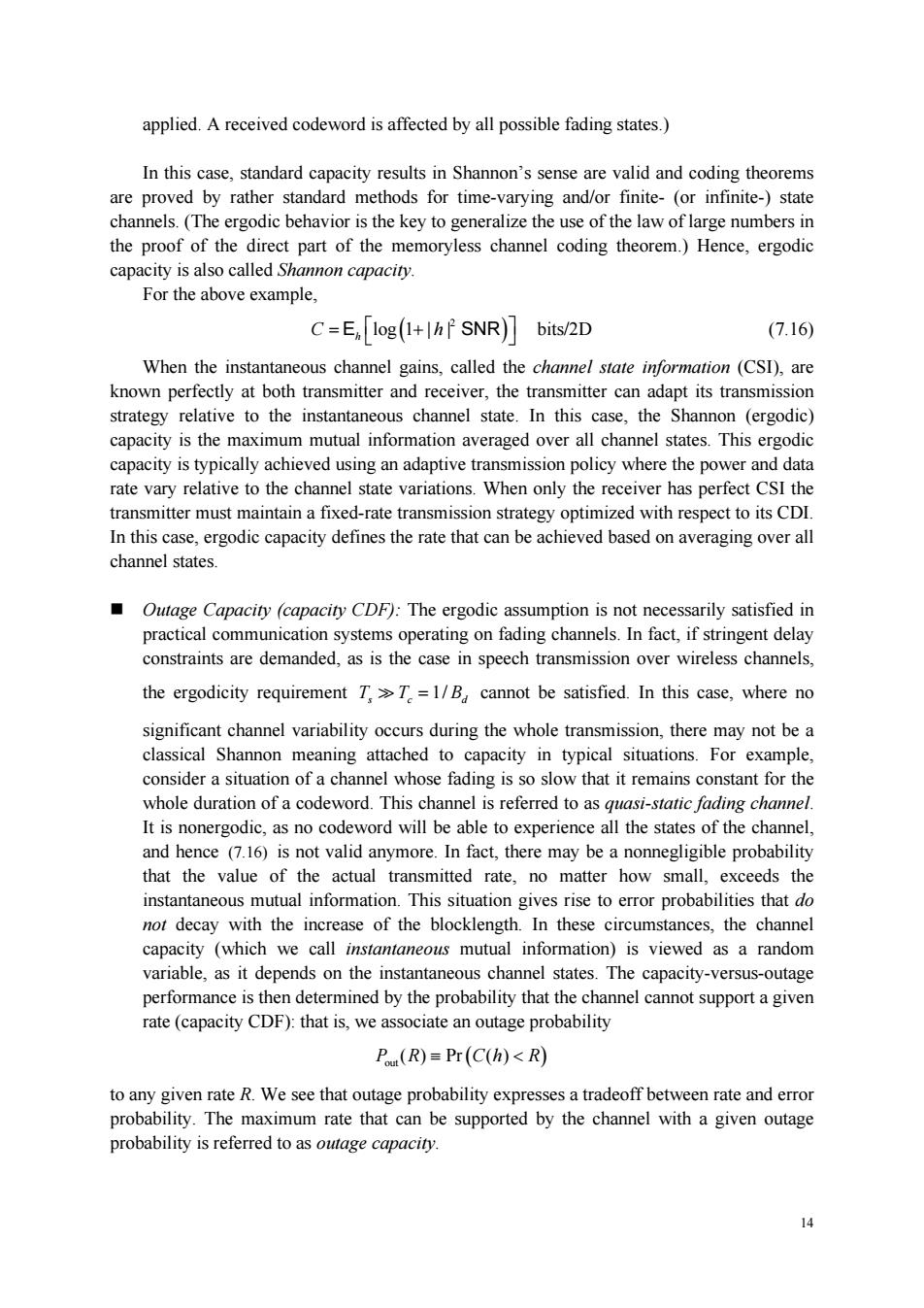正在加载图片...

applied.A received codeword is affected by all possible fading states.) In this case,standard capacity results in Shannon's sense are valid and coding theorems are proved by rather standard methods for time-varying and/or finite-(or infinite-)state channels.(The ergodic behavior is the key to generalize the use of the law of large numbers in the proof of the direct part of the memoryless channel coding theorem.)Hence,ergodic cap ity is also called Shannon capacity. For the above example. C=E,log(1+SNR)bits/2D (7.16) When the instantaneous channel gains,called the channel state information (CSI),are strategy relative to the instant nnel state In this ase,the (ergodic capacity is the maximum mutual information averaged over all channel states.This ergodic capacity is typically achieved using an adaptive transmission policy where the power and data rate vary relative to the channel state variations.When only the receiver has perfect CSI the transmitter must maintain a fixed-rate transmission strategy optimized with respect to its CDI. n this ergodic capacity defines the rate that can be chieved based on averaging over all channel states Outage Capacity (capacity CDF):The ergodic assumption is not necessarily satisfied in practical onsysmperaingn fading chane In factndelay constraints are demanded,as is the case in speech transmission over wireless channels, the ergodicity requirement T=1/B cannot be satisfied.In this case,where no significant channel variability occurs during the whole transmission,there may not be a classical Shannon meaning attached to capacity in typical situations.For example, consider a situation of a channel whose fading is so slow that it remains constant for the whole duration of a codev ord This char nnel s referred to as ng cha It is nonergodic,as no codeword will be able to experience all the state es of the channel and hence (7.16)is not valid anymore.In fact,there may be a nonnegligible probability that the value of the actual transmitted rate,no matter how small,exceeds the instantaneous mutual information.This situation gives rise to error probabilities that do not decay with the increase of the blocklength.In these circumstances,the channel capacity (whic we call al information)is viewed as a random variable,as it depends on the instantaneous channel states.The capacity-versus-outage performance is then determined by the probability that the channel cannot support a given rate (capacity CDF):that is,we associate an outage probability P(R)=Pr(C(h)<R) to any given rate R.We see that outage probability expresses a tradeoff between rate and error probability.The maximum rate that can be supported by the channel with a given outage probability is referred to as outage capacity.14 applied. A received codeword is affected by all possible fading states.) In this case, standard capacity results in Shannon’s sense are valid and coding theorems are proved by rather standard methods for time-varying and/or finite- (or infinite-) state channels. (The ergodic behavior is the key to generalize the use of the law of large numbers in the proof of the direct part of the memoryless channel coding theorem.) Hence, ergodic capacity is also called Shannon capacity. For the above example, 2 log 1 | | C h h E SNR bits/2D (7.16) When the instantaneous channel gains, called the channel state information (CSI), are known perfectly at both transmitter and receiver, the transmitter can adapt its transmission strategy relative to the instantaneous channel state. In this case, the Shannon (ergodic) capacity is the maximum mutual information averaged over all channel states. This ergodic capacity is typically achieved using an adaptive transmission policy where the power and data rate vary relative to the channel state variations. When only the receiver has perfect CSI the transmitter must maintain a fixed-rate transmission strategy optimized with respect to its CDI. In this case, ergodic capacity defines the rate that can be achieved based on averaging over all channel states. Outage Capacity (capacity CDF): The ergodic assumption is not necessarily satisfied in practical communication systems operating on fading channels. In fact, if stringent delay constraints are demanded, as is the case in speech transmission over wireless channels, the ergodicity requirement 1/ TT B s c d cannot be satisfied. In this case, where no significant channel variability occurs during the whole transmission, there may not be a classical Shannon meaning attached to capacity in typical situations. For example, consider a situation of a channel whose fading is so slow that it remains constant for the whole duration of a codeword. This channel is referred to as quasi-static fading channel. It is nonergodic, as no codeword will be able to experience all the states of the channel, and hence (7.16) is not valid anymore. In fact, there may be a nonnegligible probability that the value of the actual transmitted rate, no matter how small, exceeds the instantaneous mutual information. This situation gives rise to error probabilities that do not decay with the increase of the blocklength. In these circumstances, the channel capacity (which we call instantaneous mutual information) is viewed as a random variable, as it depends on the instantaneous channel states. The capacity-versus-outage performance is then determined by the probability that the channel cannot support a given rate (capacity CDF): that is, we associate an outage probability out P R Ch R ( ) Pr ( ) to any given rate R. We see that outage probability expresses a tradeoff between rate and error probability. The maximum rate that can be supported by the channel with a given outage probability is referred to as outage capacity